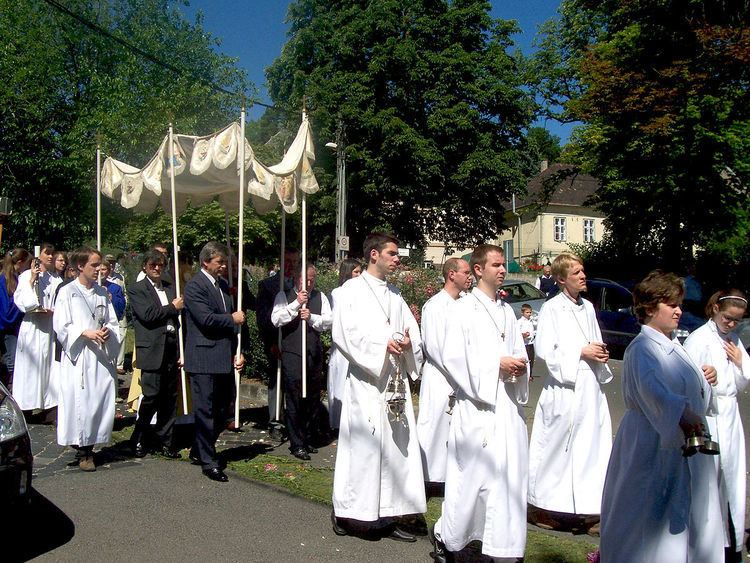 | ||
Pange Lingua Gloriosi Corporis Mysterium is a Medieval Latin hymn written by Saint Thomas Aquinas (1225–1274) for the Feast of Corpus Christi. It is also sung on Maundy Thursday during the procession from the church to the place where the Blessed Sacrament is kept until Good Friday. The last two stanzas (called, separately, Tantum Ergo) are sung at Benediction of the Blessed Sacrament. The hymn expresses the doctrine that the bread and wine are changed into the Body and Blood of Christ during the celebration of the Eucharist.
Contents
It is often sung in English as the hymn Of the Glorious Body Telling, to the same tune as the Latin.
The opening words recall another famous Latin sequence, from which this hymn is derived: Pange Lingua Gloriosi Proelium Certaminis by Venantius Fortunatus.
Text
There are many English translations, of varying rhyme scheme and metre. The following is the Latin text with a doxology, and an English translation by Fr. Edward Caswall:. The third column is a more literal rendering.
Music history
There are two plainchant settings of the Pange lingua hymn. The better known is a Phrygian mode tune from the Roman liturgy, and the other is from the Mozarabic liturgy from Spain. The Roman tune was originally part of the Gallican Rite.
The Roman version of the Pange lingua hymn was the basis for a famous composition by Renaissance composer Josquin des Prez, the Missa Pange lingua. An elaborate fantasy on the hymn, the mass is one of the composer's last works and has been dated to the period from 1515 to 1521, since it was not included by Petrucci in his 1514 collection of Josquin's masses, and was published posthumously. In its simplification, motivic unity and close attention to the text it has been compared to the late works of Beethoven, and many commentators consider it one of the high points of Renaissance polyphony.
Juan de Urrede, a Flemish composer active in Spain in the late fifteenth century, composed numerous settings of the Pange lingua, most of them based on the original Mozarabic melody. One of his versions for four voices became one of the most popular pieces of the sixteenth century, and was the basis for dozens of keyboard works in addition to masses, many by Spanish composers.
Building on Josquin's treatment of the hymn's third line in the Kyrie of the Missa Pange Lingua, the "Do-Re-Fa-Mi-Re-Do"-theme became one of the most famous in music history, used to this day in even non-religious works such as Wii Sports Resort. Simon Lohet, Michelangelo Rossi, François Roberday, Johann Caspar Ferdinand Fischer, Johann Jakob Froberger, Johann Caspar Kerll, Johann Sebastian Bach, Johann Fux wrote fugues on it, and the latter's extensive elaborations in the Gradus ad Parnassum made it known to every aspiring composer - among them Wolfgang Amadeus Mozart, whose Jupiter theme borrows the first four notes. Anton Bruckner's first composition was a setting of the first strophe of the hymn: Pange lingua, WAB 31.
The last two verses of Pange lingua (Tantum ergo) are often separated out. They mark the end of the procession of the monstrance in Holy Thursday liturgy. Various separate musical settings have been written for this, including one by Giovanni Pierluigi da Palestrina, one by Franz Schubert, eight by Anton Bruckner, one by Maurice Duruflé, and one by Charles-Marie Widor.
Franz Liszt's Night Procession from Two Episodes from Lenau's Faust is largely a fantasy on the Pange lingua melody.
A setting of Pange lingua, written by Ciaran McLoughlin and produced by Paul MacAree, appears on the Solas album Solas An Domhain.
Pange lingua has been translated into many different languages for worship throughout the world. However, the Latin version remains the most popular. The Syriac translation of Pange lingua was used as part of the rite of benediction in the Syro-Malabar Church of Kerala, India, until the 1970s.
